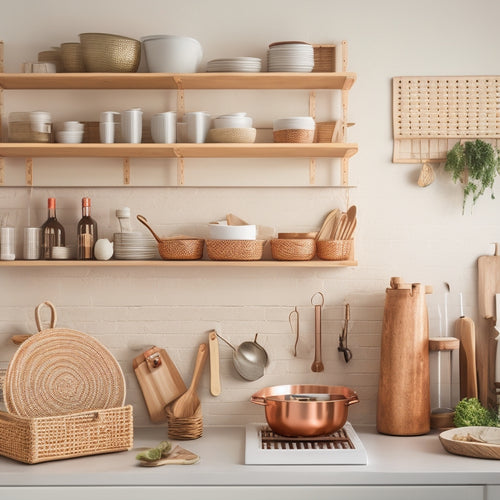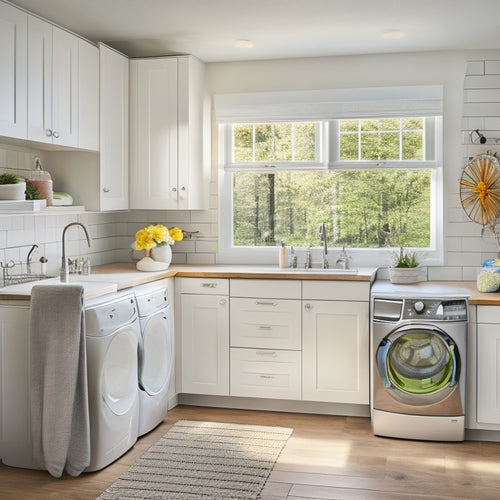
7 Essential Kitchen Organization Tips for Special Diets
Share
You're managing a special diet, and your kitchen is bursting with unique ingredients and equipment, making meal prep a challenging task that requires precision and organization. To tame the chaos, start by designating zones for different dietary needs and labeling pantry items for easy identification. Utilize vertical storage spaces, assigning tasks to specific stations to optimize meal prep. Implement a 'First In, First Out' rule to avoid food waste, and create a meal planning station to streamline your workflow. Finally, optimize cabinet and shelf storage to guarantee easy access to special diet staples. Now, get ready to take your kitchen organization to the next level!
Key Takeaways
• Designate specific kitchen zones for different dietary needs and label pantry items for easy identification and categorization.
• Maximize vertical storage spaces with adjustable racks and a rotation system to ensure accessibility of special dietary essentials.
• Assign tasks to specific stations for optimized meal prep, reducing clutter and making the most of space for special diet needs.
• Implement a 'First In, First Out' rule and track expiration dates to reduce food waste and spoilage in special diets with limited shelf-life ingredients.
• Create a meal planning station with recipe binders, shopping lists, and a magnetic meal planner to plan, shop, and cook with confidence for special diets.
Designate Zones for Dietary Needs
By designating specific zones in your kitchen for different dietary needs, you can efficiently store and access the ingredients and cooking tools required for each special diet. This strategic approach to pantry organization will streamline your meal prep process, saving you time and reducing stress.
For instance, consider dedicating a section of your pantry to gluten-free products, another to vegan staples, and a third to sugar-free snacks. This way, you can quickly locate the ingredients you need for a particular recipe, without having to sift through your entire pantry.
Within each zone, organize your ingredients and tools in a logical and accessible manner. Store heavy items, like pots and pans, near the cooking station, while lighter items, like spices and oils, can be placed on higher shelves.
Label and Categorize Pantry Items
You'll be able to maintain the organization you've established by labeling and categorizing your pantry items, making sure that everything has a designated place and is easily identifiable. This step is vital for special diets, as it helps you quickly identify which ingredients are suitable for your dietary needs.
Start by grouping similar items together, such as grains, canned goods, and baking supplies. Then, label each category using clear and concise labels. This will enable you to see what you have at a glance, making meal planning and grocery shopping more efficient.
Consider using a color-coding system to differentiate between ingredients that are gluten-free, vegan, or contain common allergens. You can also label each item with its expiration date to guarantee you're using the oldest items first.
By implementing an inventory organization system, you'll be able to keep track of what you have in stock and avoid duplicate purchases. This won't only save you time and money but also reduce food waste.
With a well-organized pantry, you'll be able to focus on meal prep and cooking, rather than searching for ingredients.
Utilize Vertical Storage Spaces
When organizing your kitchen for a special diet, you'll want to make the most of your storage spaces. By utilizing vertical storage, you'll free up valuable floor and counter space, and create a more efficient kitchen.
Now, let's explore how to maximize shelf height, store less-used items, and optimize corner spaces to create a customized storage system that works for you.
Maximize Shelf Height
Your kitchen's vertical storage spaces can be a game-changer for maximizing shelf height, allowing you to stock up on special dietary essentials without sacrificing valuable counter space. By installing customized shelving, you can create space-saving solutions that cater to your unique needs.
For instance, you can designate specific shelves for gluten-free products, nut-free snacks, or vegan staples.
To further optimize your shelf height, consider using adjustable racks that can be tailored to fit different sizes of containers and products. This efficient organization system enables you to store more items in a smaller footprint, keeping your countertops clear and clutter-free.
By doing so, you'll be able to quickly locate the ingredients you need, making meal prep a breeze. Additionally, adjustable racks allow you to adapt your storage setup as your dietary needs evolve.
Store Less-Used Items
By relegating less-frequently utilized special dietary items to higher or lower shelves, you can free up prime storage space for everyday essentials. This vertical storage strategy allows you to keep items accessible without cluttering your countertops. Implement a rotation system to make certain that less-used items are still easily accessible when needed.
| Less-Frequently Used Items | Storage Solution |
|---|---|
| Seasonal items (e.g., holiday-themed cookie cutters) | Hidden storage bins or containers on higher shelves |
| Infrequently used cookbooks | Organization bins with labels on lower shelves |
| Special occasion dishes | Stackable storage units on higher shelves |
| Rarely used kitchen gadgets | Small, labeled baskets on lower shelves |
| Out-of-season pantry items | Airtight containers on higher shelves |
Optimize Corner Spaces
Now that you've freed up prime storage space by relegating less-frequently used items, turn your attention to corner spaces, where clever use of vertical storage can access additional capacity.
These often-wasted areas can be optimized with lazy susan solutions, which provide easy access to items while keeping them hidden from view.
Consider installing pull-out drawers or rotating shelves to maximize the storage potential of these corners.
This will allow you to store items like infrequently used cookbooks, special dietary ingredients, or cooking utensils, keeping them organized and out of the way.
Assign Tasks to Specific Stations
When you assign specific tasks to particular stations in your kitchen, you'll find that meal prep becomes more efficient and streamlined.
By designating areas for tasks like chopping, cooking, and cleaning, you'll reduce clutter and make the most of your space.
This approach will help you stay focused and guarantee that your special diet needs are met with ease.
Meal Prep Zones
Designating specific stations for tasks like chopping, cooking, and packaging helps you optimize your meal prep workflow and reduce clutter. By assigning tasks to specific stations, you're able to delegate tasks more efficiently and streamline your meal prep process. This is especially important when catering to special diets, as it guarantees you're meeting specific dietary needs without compromising on time efficiency.
For instance, you can designate a chopping station with all the necessary tools and ingredients, making it easier to prep ingredients for your meals.
A cooking station can be set up with all the necessary cookware and appliances, allowing you to focus on cooking without distractions.
Similarly, a packaging station can be organized with containers, labels, and other essentials, making it easy to portion and store meals.
Designate Workflow Areas
By setting up distinct workflow areas, you can further optimize your kitchen organization and meal prep efficiency by assigning specific tasks to each station. This approach helps you navigate your kitchen layout more effectively, especially when accommodating dietary restrictions.
Identify the tasks that require the most attention, such as food prep, cooking, and cleanup, and designate a specific area for each.
Assigning tasks to specific stations enhances workflow efficiency and reduces clutter. For instance, dedicate a station for meal prep, equipped with utensils and appliances needed for chopping, slicing, and dicing. This station can also serve as a hub for meal planning, where you can store cookbooks, recipe cards, and meal planning calendars.
By separating tasks into distinct areas, you'll improve your ability to manage dietary needs and restrictions. This approach also helps you maintain a clean and organized kitchen, reducing the risk of cross-contamination and ensuring a safe cooking environment.
Implement a "First In, First Out" Rule
You'll avoid expired ingredients and reduce food waste by implementing a 'first in, first out' rule in your kitchen, making sure that older items are consumed before newer ones. This inventory management technique is essential, especially when dealing with special diets that require specific ingredients with limited shelf lives.
By keeping track of expiration dates, you can guarantee that you're using the oldest items first, reducing the risk of spoilage and waste.
To make this system work, establish a rotation system for your pantry and fridge. Store newer items behind older ones, and consider labeling them with the date they were purchased or opened. When meal planning, prioritize recipes that use the oldest ingredients first. This will help you stay on top of your inventory and avoid last-minute scrambles to use up expired items.
Create a Meal Planning Station
With your inventory organized and rotating smoothly, it's time to focus on planning meals that incorporate your special diet ingredients, and a dedicated meal planning station can help you do just that. This station will be your go-to spot for planning healthy, delicious meals that cater to your dietary needs.
Start by creating a recipe binder filled with your favorite recipes, along with notes on modifications and substitutions to accommodate your special diet. Next to your binder, keep a shopping list where you can jot down ingredients you need to pick up.
Consider investing in a magnetic meal planner, where you can plan out your meals for the week and make adjustments as needed. This will help you stay on track and avoid last-minute takeout or unhealthy impulse buys.
Additionally, use a grocery organizer to keep track of your pantry staples and make certain you're always stocked with the ingredients you need. With your meal planning station in place, you'll be able to plan, shop, and cook with confidence, making it easier to stick to your special diet.
Optimize Cabinet and Shelf Storage
Five key zones in your kitchen cabinets and shelves require optimization to guarantee easy access to special diet staples and ingredients. By streamlining these areas, you'll save time and reduce frustration when cooking for specific dietary needs.
| Zone | Optimization Tip | Recommended Product |
|---|---|---|
| Upper Cabinets | Install stackable containers or baskets to store infrequently used items | Stackable Containers |
| Lower Cabinets | Use drawer dividers to separate specialty ingredients and cooking supplies | Drawer Dividers |
| Pantry Shelves | Organize items by category (e.g., gluten-free, vegan) and expiration date | Under Cabinet Baskets |
| Refrigerator | Utilize refrigerator bins to store fresh produce and dairy alternatives | Refrigerator Bins |
Related Posts
-

Revolutionize Your Kitchen Storage With These Ideas
You're ready to revolutionize your kitchen storage! Start by incorporating ladder-accessible shelves and utilizing cl...
-

Revamp Your Laundry Room With Smart Space-Saving
You're tired of feeling cramped and disorganized in your laundry room, and it's time to revamp the space to make the ...

